非谓语动词---------分词的用法及总结
非谓语动词的用法总结
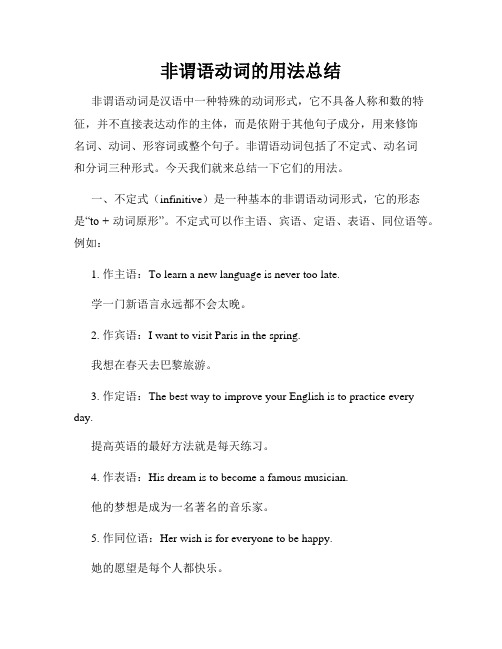
非谓语动词的用法总结非谓语动词是汉语中一种特殊的动词形式,它不具备人称和数的特征,并不直接表达动作的主体,而是依附于其他句子成分,用来修饰名词、动词、形容词或整个句子。
非谓语动词包括了不定式、动名词和分词三种形式。
今天我们就来总结一下它们的用法。
一、不定式(infinitive)是一种基本的非谓语动词形式,它的形态是“to + 动词原形”。
不定式可以作主语、宾语、定语、表语、同位语等。
例如:1. 作主语:To learn a new language is never too late.学一门新语言永远都不会太晚。
2. 作宾语:I want to visit Paris in the spring.我想在春天去巴黎旅游。
3. 作定语:The best way to improve your English is to practice every day.提高英语的最好方法就是每天练习。
4. 作表语:His dream is to become a famous musician.他的梦想是成为一名著名的音乐家。
5. 作同位语:Her wish is for everyone to be happy.她的愿望是每个人都快乐。
二、动名词(gerund)是名词化的动词,它的形态是动词的现在分词形式(V-ing),可以作主语、宾语、定语、表语等。
例如:1. 作主语:Swimming is good for your health.游泳对身体健康有好处。
2. 作宾语:He enjoys playing basketball in his free time.他喜欢在空闲时间打篮球。
3. 作定语:I have a meeting with my boss this afternoon.我今天下午有个与老板的会议。
4. 作表语:Her favorite activity is dancing.她最喜欢的活动是跳舞。
非谓语动词-现在分词的讲解

非谓语动词非谓语动词包括不定式(to do)、动名词(-ing)、现在分词(-ing)与过去分词(-ed)。
它们不受主语人称和数的限制,在句子中不能充当谓语,但可以充当句子的其他成分,并且有时态和语态的变化。
动词-ing形式的要点1.-ing的形式2.-ing形式的基本用法(1)作主语:Seeing is believing. 眼见为实。
(2)作表语:Her job is washing and cooking.(3)作宾语:①作及物动词的宾语。
She likes drawing very much.②作某些短语动词的宾语。
Mary is thinking of going back to New York.③ do+限定词(my, some, any, the等)+v.-ing,表示“做…事”之如do some cleaning打扫卫生do some shopping购物④作介词的宾语:Her sister is good at learning physics.⑤作形容词worth, busy等的宾语:This book is well worth reading.只接动词-ing形式而不接不定式作宾语的动词有:admit 承认appreciate 感激avoid 避免put off推迟keep 保持consider 考虑delay/ postpone耽搁dislike 嫌恶resist 抵制mention 提及enjoy 喜欢escape 避免excuse 原谅practice 练习mind介意fancy想不到feel like 意欲finish 完成risk 冒险include 包括forgive 原谅give up 放弃suggest 建议miss 逃过imagine 想象can’t help 情不自禁involve 需要can’t stand无法忍受understand 理解常见的带介词to的短语:be used to 习惯be related to 与……有关get down to 着手做contribute to 贡献put one’s mind to全神贯注于give rise to 引起be equal to 胜任devote oneself to 献身于lead to 导致be opposed to 反对look forward to 盼望object to 反对stick to 坚持pay attention to 注意(4)作定语:The sleeping child is only five years old.(5)作宾语补足语:We can see steam rising from the wet clothes.可以带有这种复合宾语的动词有see, watch, hear, observe, feel, find, have, keep等。
英语非谓语动词用法总结
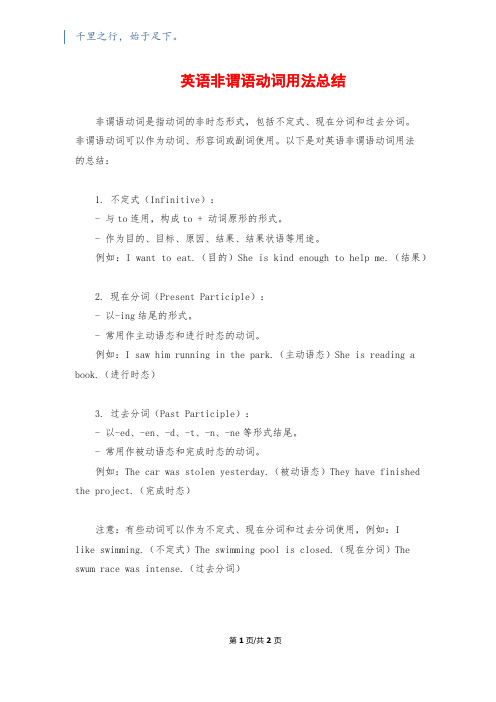
千里之行,始于足下。
英语非谓语动词用法总结非谓语动词是指动词的非时态形式,包括不定式、现在分词和过去分词。
非谓语动词可以作为动词、形容词或副词使用。
以下是对英语非谓语动词用法的总结:1. 不定式(Infinitive):- 与to连用,构成to + 动词原形的形式。
- 作为目的、目标、原因、结果、结果状语等用途。
例如:I want to eat.(目的)She is kind enough to help me.(结果)2. 现在分词(Present Participle):- 以-ing结尾的形式。
- 常用作主动语态和进行时态的动词。
例如:I saw him running in the park.(主动语态)She is reading a book.(进行时态)3. 过去分词(Past Participle):- 以-ed、-en、-d、-t、-n、-ne等形式结尾。
- 常用作被动语态和完成时态的动词。
例如:The car was stolen yesterday.(被动语态)They have finished the project.(完成时态)注意:有些动词可以作为不定式、现在分词和过去分词使用,例如:Ilike swimming.(不定式)The swimming pool is closed.(现在分词)The swum race was intense.(过去分词)第1页/共2页锲而不舍,金石可镂。
此外,非谓语动词还有一些特殊的用法和结构,包括不定式的被动形式、独立结构、状语从句、动名词(-ing形式)和不定式的短语等。
总之,非谓语动词在英语语法中发挥重要作用,熟练掌握其用法对于正确使用英语具有重要意义。
非谓语动词分类及用法

非谓语动词分类及用法非谓语动词主要包括不定式、动名词和分词(现在分词和过去分词)三种。
以下是它们的分类和用法:1. 不定式:不定式是非谓语动词中最常见的形式,由“to+动词原形”构成。
它既可以作为主语、宾语,也可以作为定语、状语等。
不定式的否定形式是在“to”前面加上“not”。
不定式作为主语,表示一种意愿或目的,例如:To study English is important.(学习英语很重要。
)不定式作为宾语,表示一种动作或行为,例如:I want to go home.(我想回家。
)不定式作为定语,修饰名词或代词,例如:I have a lot of homework to do.(我有很多作业要做。
)不定式作为状语,表示目的、结果或原因等,例如:I went to the library to read books.(我去了图书馆看书。
)2. 动名词:动名词由动词原形加“-ing”构成,具有名词的语法功能,在句子中可以作主语、宾语等。
动名词一般表示一种习惯或抽象的动作。
动名词作为主语,表示一种状态或抽象概念,例如:Reading books is a good habit.(读书是一个好习惯。
)动名词作为宾语,表示一种行为或动作,例如:I enjoy listening to music.(我喜欢听音乐。
)3. 分词:分词分为现在分词和过去分词两种。
现在分词由动词原形加“-ing”构成,过去分词由动词原形加“-ed”构成。
分词在句子中可以作定语、状语等。
现在分词作为定语,修饰名词或代词,例如:The running man is my brother.(那个跑步的人是我的哥哥。
)过去分词作为定语,修饰名词或代词,例如:The developed country has higher living standards.(发达国家的生活水平更高。
)现在分词作为状语,表示时间、条件、让步等关系,例如:If you continue to work hard, you will succeed.(如果你继续努力工作,你会成功的。
分词非谓语动词讲解
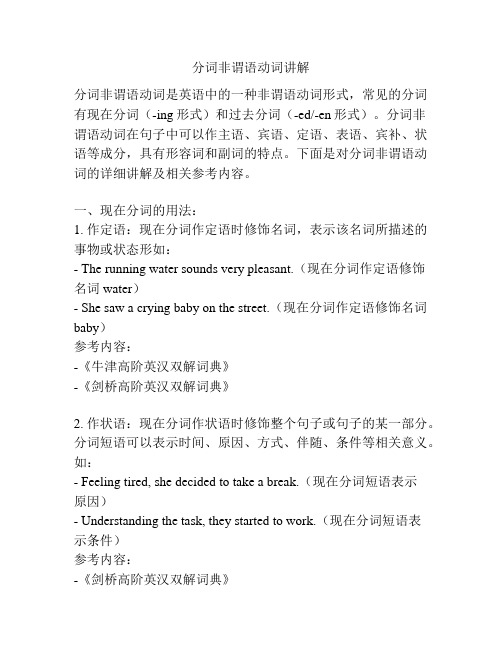
分词非谓语动词讲解分词非谓语动词是英语中的一种非谓语动词形式,常见的分词有现在分词(-ing形式)和过去分词(-ed/-en形式)。
分词非谓语动词在句子中可以作主语、宾语、定语、表语、宾补、状语等成分,具有形容词和副词的特点。
下面是对分词非谓语动词的详细讲解及相关参考内容。
一、现在分词的用法:1. 作定语:现在分词作定语时修饰名词,表示该名词所描述的事物或状态形如:- The running water sounds very pleasant.(现在分词作定语修饰名词water)- She saw a crying baby on the street.(现在分词作定语修饰名词baby)参考内容:-《牛津高阶英汉双解词典》-《剑桥高阶英汉双解词典》2. 作状语:现在分词作状语时修饰整个句子或句子的某一部分。
分词短语可以表示时间、原因、方式、伴随、条件等相关意义。
如:- Feeling tired, she decided to take a break.(现在分词短语表示原因)- Understanding the task, they started to work.(现在分词短语表示条件)参考内容:-《剑桥高阶英汉双解词典》-《英汉大词典》二、过去分词的用法:1. 作定语:过去分词在句中作定语时,修饰名词,表示该名词被动、完成或被描述的状态,如:- The broken vase needs to be repaired.(过去分词作定语修饰名词vase)- The information provided is accurate.(过去分词作定语修饰名词information)参考内容:-《朗文当代高级英语辞典》-《剑桥国际英语高级词典》2. 作表语:过去分词可以作表语,表示主语的状态或特征,如:- He is interested in the books written by the famous author.(过去分词作表语修饰主语)- The glass is broken.(过去分词作表语修饰主语)参考内容:-《剑桥高阶英汉双解词典》-《牛津高阶英汉双解词典》三、分词作宾补的用法:分词非谓语动词可以作及物动词的宾语补足语,表示被动、完成的意义,如:- She found the door locked.(分词作宾补修饰宾语door)- They heard the news announced on the radio.(分词作宾补修饰宾语news)参考内容:-《韦氏英语用法词典》-《剑桥高阶英汉双解词典》综上所述,分词非谓语动词的用法主要包括现在分词作定语、状语,过去分词作定语、表语和宾补等。
新概念2 非谓语动词 - 分词做状语 归纳总结
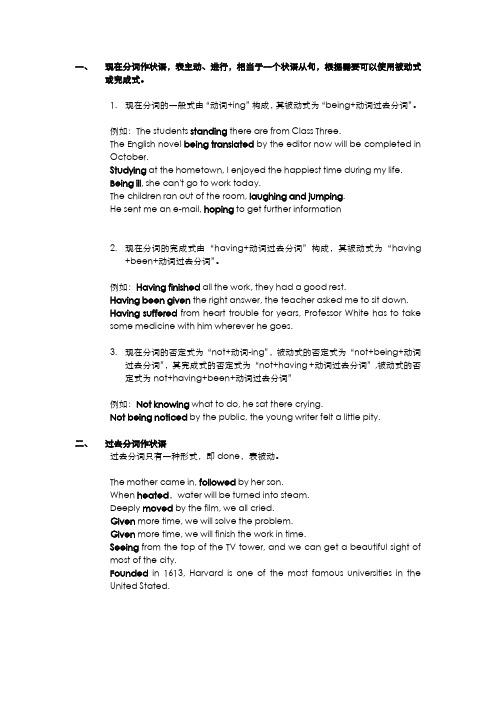
一、现在分词作状语,表主动、进行,相当于一个状语从句,根据需要可以使用被动式或完成式。
1.现在分词的一般式由“动词+ing”构成,其被动式为“being+动词过去分词”。
例如:The students standing there are from Class Three.The English novel being translated by the editor now will be completed inOctober.Studying at the hometown, I enjoyed the happiest time during my life.Being ill, she can't go to work today.The children ran out of the room, laughing and jumping.He sent me an e-mail, hoping to get further information2.现在分词的完成式由“having+动词过去分词”构成,其被动式为“having+been+动词过去分词”。
例如:Having finished all the work, they had a good rest.Having been given the right answer, the teacher asked me to sit down.Having suffered from heart trouble for years, Professor White has to takesome medicine with him wherever he goes.3.现在分词的否定式为“not+动词-ing”,被动式的否定式为“not+being+动词过去分词”,其完成式的否定式为“not+having +动词过去分词”,被动式的否定式为not+having+been+动词过去分词”例如:Not knowing what to do, he sat there crying.Not being noticed by the public, the young writer felt a little pity.二、过去分词作状语过去分词只有一种形式,即done,表被动。
非谓语动词的分类及用法总结

非谓语动词的分类及用法总结非谓语动词是指不具备谓语功能的动词形式,包括不定式、动名词和分词。
它们在句中作不同的成分,具有丰富的用法和特点。
本文将对非谓语动词的分类及其用法进行总结。
一、不定式(Infinitive)不定式是动词的一种非限定形式,具有名词、形容词和副词的特点。
不定式一般由动词原形加上“to”构成,也有少数动词不加“to”。
分类:1. 基本不定式:- 例句:I want to go to the movies tonight.(我今晚想去看电影)2. 省略to的不定式:- 例句:Let me help you.(让我来帮你)3. 完全不定式(动词+不定式符号to):- 例句:I want you to listen to me.(我希望你听我说)用法:1.作主语:- 例句:To learn a foreign language requires patience.(学习外语需要耐心)2.作宾语:- 例句:I like to play tennis.(我喜欢打网球)3.作宾语补足语:- 例句:He made her cry. (他使她哭了)4.作定语:- 例句:I have a lot of work to do.(我有很多工作要做)5.作状语:- 例句:He came to borrow some money.(他来借些钱)二、动名词(Gerund)动名词是动词的一种非限定形式,具有名词特点,一般以动词原形加上“-ing”构成。
分类:1. 一般动名词:- 例句:Walking helps keep you healthy.(散步有助于保持健康)2. 所有格形式动名词:- 例句:I appreciate his helping me.(我感激他帮助我)用法:1.作主语:- 例句:Swimming is good for you.(游泳对你有好处)2.作宾语:- 例句:I enjoy reading books.(我喜欢读书)3.作宾语补足语:- 例句:I heard him singing in the shower.(我听见他在洗澡时唱歌)4.作定语:- 例句:She likes playing the piano.(她喜欢弹钢琴)5.作状语:- 例句:He learned English by watching movies.(他通过看电影学英语)三、分词(Participle)分词是动词的一种非限定形式,具有形容词和副词的特点,一般以动词原形加上“-ing”或“-ed”构成。
(完整版)非谓语的用法总结
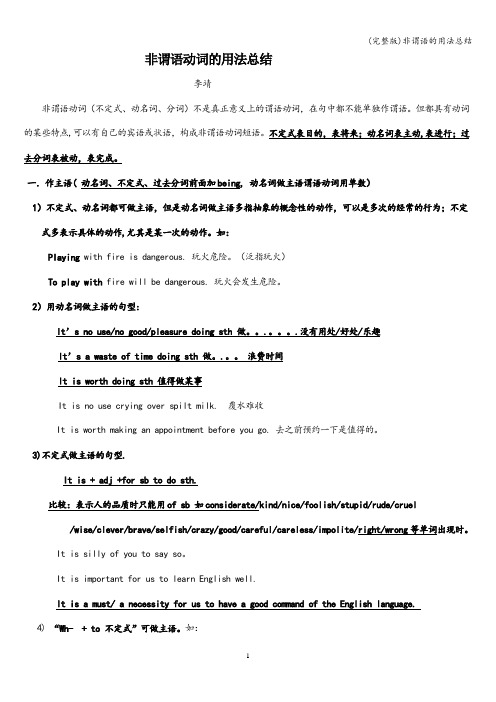
非谓语动词的用法总结李靖非谓语动词(不定式、动名词、分词)不是真正意义上的谓语动词,在句中都不能单独作谓语。
但都具有动词的某些特点,可以有自己的宾语或状语,构成非谓语动词短语。
不定式表目的,表将来;动名词表主动,表进行;过去分词表被动,表完成。
一.作主语( 动名词、不定式、过去分词前面加being, 动名词做主语谓语动词用单数)1)不定式、动名词都可做主语,但是动名词做主语多指抽象的概念性的动作,可以是多次的经常的行为;不定式多表示具体的动作,尤其是某一次的动作。
如:Playing with fire is dangerous. 玩火危险。
(泛指玩火)To play with fire will be dangerous. 玩火会发生危险。
2)用动名词做主语的句型:It’s no use/no good/pleasure doing sth 做。
.。
.没有用处/好处/乐趣It’s a waste of time doing sth 做。
.。
浪费时间It is worth doing sth 值得做某事It is no use crying over spilt milk. 覆水难收It is worth making an appointment before you go. 去之前预约一下是值得的。
3)不定式做主语的句型.It is + adj +for sb to do sth.比较:表示人的品质时只能用of sb 如considerate/kind/nice/foolish/stupid/rude/cruel /wise/clever/brave/selfish/crazy/good/careful/careless/impolite/right/wrong等单词出现时。
It is silly of you to say so。
It is important for us to learn English well.It is a must/ a necessity for us to have a good command of the English language.4) “Wh- + to 不定式”可做主语。
